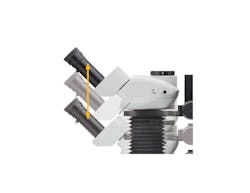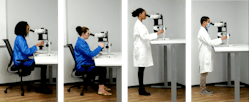For anyone using an industrial microscope for more than 50% of their working hours, ergonomics—the organization and placement of tools and equipment people use to perform more effectively—is crucial. Ergonomic microscopes and work environments promote user comfort by reducing risks of injuries and acute pain. Ergo-friendly workstations optimize efficiency by providing a comfortable setup and strategic positioning of items for easy access with minimal movement.
Many users don’t realize how important it is to incorporate proper ergonomics into their microscope setup and routine (see “Make it part of your routine”). In a study by A. A. Gupta et al., researchers found that approximately 50% of the participants (microscopists for pathology, microbiology, and oral pathology) were unaware of the importance of ergonomics.1 This highlights the significance of educating management and microscope users about ergonomics to prevent injuries and increase productivity.
Consequences of poor ergonomics
Poor ergonomics can lead to work-related musculoskeletal disorders (MSDs) that harm muscles, nerves, blood vessels, ligaments, and tendons. MSDs include injuries such as carpal tunnel syndrome, tendinitis, rotator cuff injuries, and muscle strains, which often require rest and rehabilitation and sometimes surgery to mitigate the pain they cause. According to the Bureau of Labor Statistics, MSDs contributed to 33% of all worker injury and illness cases in 2013, making them a major cause of lost work time. The issue is as important to employers as to professionals using microscopes.
There are multiple factors that lead to lack of ergonomics in the microscopy world:
Microscopes that are not adjustable do not facilitate/enable proper ergonomics for diverse users. If the height and angle of the eyepieces are not adjustable, not all users will be able to operate the microscope with a neutral spine and neck. This can lead to users hunching and straining over the microscope to view their samples. Adjustable components (see Fig. 1) are incredibly valuable for ergonomics because they allow each user to tailor the setup for their stature.
Most work areas were not designed with ergonomics in mind. If the microscope workstation is not set up for ergonomic use, it can make work more difficult and less efficient. Having a bulky microscope on a table that is too high or too short can force the user to strain to reach focus knobs or exchange samples. It is important to select lumbar-supported chairs to cushion the user’s back while sitting; it can be beneficial to pair this with a sitting-to-standing desk to allow users to switch their working stance (see Fig. 2).Neglected microscope maintenance can cause unnecessary strain. Maintaining a fully functional microscope is vital. If the microscope’s illumination has weakened its light intensity, this can make it challenging for the user to see areas of interest on the sample, resulting in eye strain and fatigue. Poor microscope maintenance, such as a broken focus/adjustment knob that no longer moves with ease, requires the user to adjust the microscope with a greater amount of force.
It is also important to address non-ergonomic equipment and workstations because these can have negative effects on individual employees and the company as a whole.
Economic impacts of repetitive strain injuries
Workers’ compensation from injuries associated with lack of proper ergonomics can cost companies billions of dollars annually, resulting in considerable financial burden. Routine microscopy operation is among high-risk jobs for developing MSDs and other work-related injuries because of the repetitive nature of the work. To reduce the chance of injuries and workers’ compensation claims, it is important to set up and use ergonomic workstations and stereo microscopes.
Adaptable stereo microscopes for individual comfort
Newer stereo microscopes feature parts and characteristics that facilitate proper ergonomics to help users remain safe and healthy while they work. These ergonomic components allow the microscope to be personalized to the individual. Users of varying heights can adjust the newer microscopes (such as the Olympus SZX industrial microscope series, for example) so every operator can examine samples comfortably and without difficulty.
Ergonomic posture and positioning recommendations
Equipment should be within arms’ reach. Select stereo microscopes featuring focus and adjustment knobs must be located in easy-to-reach places. Microscopes with a slim design allow you to change the sample with ease and minimal arm/hand movement.
During microscope observation, you should remain in a neutral position with your back straight, neck at an angle of 20° or less, and eyes level. A tilting trinocular head allows you to adjust the eyepieces so your neck is at the optimal angle. The longer eye tubes facilitate good posture, and the extendable eyepoint height adjuster can be tailored to accommodate a variety of users.
Eye focus should be altered approximately every 30 minutes to prevent eye strain and headaches. Stereo microscopes provide excellent eye relief, allowing the operator to relax without losing the sample image. The convergence angles within the eye tubes minimize eye strain, and the interpupillary distance of the eyepieces can be adjusted with minimal force to optimize sample viewing for each user (see Fig. 3). Another important factor to prevent eye strain is proper sample illumination. Look for stereo microscopes with multiple lighting options to ensure you have the most ideal illumination for sample inspection.Your feet should be touching the floor with your knees bent at a right angle. Arms should be angled and placed on the workstation between 90° and 120°. When using a stereo microscope in routine microscopy, the entire workspace should be designed with ergonomics in mind. Setting the microscope up on an adjustable benchtop and using an adjustable chair with lumbar support helps you better maintain ergonomic positioning of your knees, arms, and feet.
Individual and company considerations
Both the management and microscope users need to be involved in the process for ensuring proper ergonomics within the workplace. It is paramount that all employees are trained about the importance of ergonomics, how to identify ergonomic issues, and the steps needed to resolve any problems. Users should bring attention to any work-related injuries, and management should work to address the potential problem that caused the injury to prevent future cases. Companies should also examine repetitive and high-risk tasks to minimize risk factors for work-related MSDs. Ergonomics should be a team effort.
ACKNOWLEDGMENT
Evident is a wholly owned subsidiary of Olympus, comprised of its former Life Science and Industrial divisions.
REFERENCE
1. A. A. Gupta et al., J. Clin. Diagn. Res., 9, 5, ZC62–ZC65 (May 2015); doi:10.7860/jcdr/2015/11742.5952.


